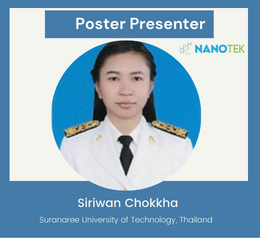Scholars Frontiers in
Nanoscience and Nanotechnology Congress
THEME: "Fostering Advancements in Nanoscience and Nanotechnology"
 27-28 Mar 2023
27-28 Mar 2023  Crowne Plaza Ealing, London, UK & Online
Crowne Plaza Ealing, London, UK & Online THEME: "Fostering Advancements in Nanoscience and Nanotechnology"
 27-28 Mar 2023
27-28 Mar 2023  Crowne Plaza Ealing, London, UK & Online
Crowne Plaza Ealing, London, UK & Online 
Suranaree University of Technology, Thailand
Conductive Material from Automotive Industrial Waste
I was born in Nakhon
Ratchasima, Thailand, in 1987. I received the B.Eng, M.Eng and Ph.D. degrees in
ceramic Engineering from Suranaree University of Technology, Thailand, in 2008,
2011 and 2015 respectively. I am currently engaged as an Assist professor in the
school of Ceramic engineering, Institute of Engineering, Suranaree University
of Technology. Nevertheless, I am a member of the Center of Excellence in
Biomechanics Medicine. My research interests include all traditional and
advanced ceramics, bio-material, Electronic and Energy material, Zero waste and
sustainability and medical device
Automotive industrial waste is increasing rapidly to
meet the demand for using an automobile, resulting in subsequent
environmental problems because the waste will be disposed by landfill. To solve
sustainable environmental problems, strong acid of HNO3 is utilized to
transform the chemical composition of iron-rich automotive manufacturing waste.
The final outcome of the chemical interaction between Fe-waste and HNO3
strong acid is a pure form of Fe2O3 that is insoluble in
water. Then,
a conductive perovskite material with the chemical formula of LaNi0.6Fe0.4O3+5 is
used mechanical grinding synthesized technique by substituting Fe2O3-waste in
Ni-metal site (B-site). The mixed
phases of LaNi0.6Fe0.4O3+5, LaNi0.75Fe0.25O3+5 and LaNiO3+5 from
automotive industrial waste after sintering at 1200oC for 2 hrs is
detected by XRD with using TOPAS software analysis in the amount of 53.13%,
29.41% and 17.46%, respectively. The LaNi0.6Fe0.4O3+d calculated perovskite material from automotive industrial waste is presented the highest electrical conductivity with a
value of 42 S/cm at 550oC. Additionally, the electrical
conducting property is mixed of metallic and semiconducting behavior with a
transition point of electrical conductivity at 550oC.
Moreover, the coefficient of thermal expansion of LaNi0.6Fe0.4O3+d synthesized sample from automotive
industrial waste is represented in the range of 12-13 1/oC, which is similar to the
electrolyte materials used in an Intermediate temperature solid oxide fuel cell
(IT-SOFC) components. The results suggested that the strong acid could change
the chemical composition of automotive industrial waste, which could then be
utilized as a starting material for synthesis of IT-SOFC conductive materials.
The experiment can reduce the amount of waste, offer additional value of
industrial waste, as well as provide a long-term sustainable solution to
environmental problems.